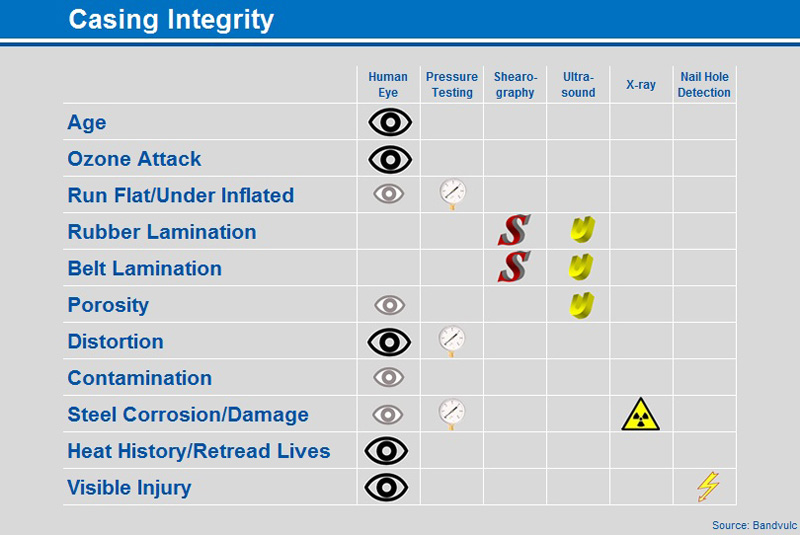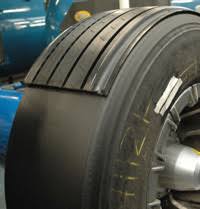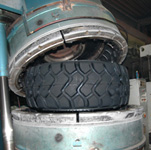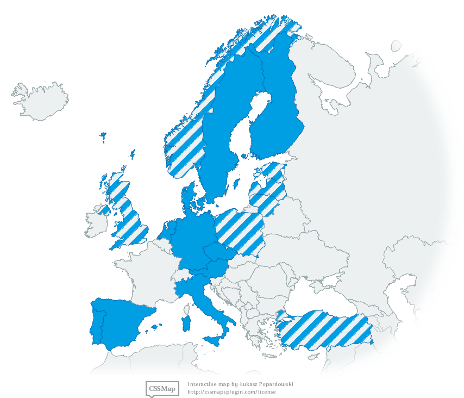Retreading: a life lengthening process
Are retreaded tyres as good as new tyres? The answer is: YES, and much more profitable.
Choosing retreaded tyres means you choose:
- Lower costs per kilometre
- Excellent quality
- A sustainable product
- Environmentally friendly product
- And, most important: Road Safety.
Every major truck tyre manufacturer manufactures its tyres for multiple lives. This means that these tyres are designed to be retreaded. Not retreading these tyres means that you simply cannot achieve the lowest costs per kilometre. In Europe one out of three truck tyres is actually a retreaded tyre. In the USA two out of five.
Custom made
Not only truck tyres, also tyres for aircrafts, public transportation, busses, tractors, earth moving machines and even car tyres can be retreaded. The only condition is that the casing integrity has to be guaranteed.
Environment
Retreading is highly environmentally friendly. The tread wears faster than the cushion layers and casing. Indeed, when the tread has worn you still can use the casing. Needless to say, the casing has to be of superior quality. Not only for road safety, but also for the use of retreading. The consistency of the quality of casings is one of the biggest concerns in the retreading industry.
Sustainability
The reuse of the casing implicitly contributes importantly to the sustainability. Reuse leads directly to less waste into the environment, as well as an important reduction of raw materials. Do we need approximately 100 litres of crude oil and 69 kg of other materials to manufacture an average new truck tyre, a retread only needs 30 litres of crude oil and merely 15 kg of materials. Therefore the carbon footprint diminishes from 220 kg of CO2 emission to only 39 kg, also due to the need of less energy.
The quality of the original casing defines the quality of the retreaded tyre. Manufacturers awareness for that particular quality do have a market advantage.
CASING INTEGRITY
Checking if the casing is suitable to be considered for retreading starts with experience and the human eye. Trained tyre technicians can quickly gain an overall impression of the general condition of the casing. This ability is based on training and years of experience.
Life Cycle Analyses
 From a visual inspection it is possible to determine: age, load/speed rating, signs of under inflation, physical damage, contamination, visual signs of casing breakup and distortion. However, visual inspection cannot detect concealed rubber lamination, belt separation, stressed or concealed broken cords or porosity. When visual inspection is not sufficient, modern technological equipment like pressure testing (distortion, spaced cords), shearography (rubber lamination and separation between belts and rubber) ultra sound (separation and porosity cords), X-ray (broken, stressed and spaced cords) and nail hole detection (finds tyre penetrations using high voltage) is used.
From a visual inspection it is possible to determine: age, load/speed rating, signs of under inflation, physical damage, contamination, visual signs of casing breakup and distortion. However, visual inspection cannot detect concealed rubber lamination, belt separation, stressed or concealed broken cords or porosity. When visual inspection is not sufficient, modern technological equipment like pressure testing (distortion, spaced cords), shearography (rubber lamination and separation between belts and rubber) ultra sound (separation and porosity cords), X-ray (broken, stressed and spaced cords) and nail hole detection (finds tyre penetrations using high voltage) is used.
Technology has given the retreader the ability to manufacture retreads equivalent to new tyres.
Detailed print
Of course the result of the casing analyses can be reported in print. The supplier can give the purchaser, prior to purchase, a detailed print of the results of the retreaded tyre. The purchaser knows that he is buying a high quality tyre which has the potential to be retreaded several times.
Guaranteed quality: Regulations UN-ECE R108 / 109
Retreading is carried out by professionals. The provisions of UNECE Regulations 108 (car tyres) and 109 (commercial tyres) is the present legislative control of the retreading market. Every retreaded tyre is recognizable by a number on the side wall of the tyre. For example: E4 109R 000008. 
E4 represents the country of type approval, certificate number of the retreading company is 109R 000008. This label ensures that retreaded tyres are approved by the similar safety and control requirements as new tyres.
RETREADING TECHNIQUES
As long as casing integrity is guaranteed tyres can be retreaded. To produce retreaded tyres two technologies are available: pre-mould retreading (cold cure) and mould-cure retreading (hot cure).
After casing integrity is guaranteed, the worn tread surface of the tyre is buffed to prepare the tyre to be retreaded.
Pre-mould retreading
 Using the technique of pre-mould retreading, hot cushion gum is extruded onto the casing filling up skives and buzz outs while laying down an ideal bonding layer. Pre-moulded treads are cut to length and applied on the casing. The cushion gum has to be vulcanized while the pre-moulded tread has to be kept in position. Therefore the casing is placed into an envelope and drawn vacuum. The envelope is put into an autoclave and by making use of time, temperature, vacuum and pressure the tyre is retreaded.
Using the technique of pre-mould retreading, hot cushion gum is extruded onto the casing filling up skives and buzz outs while laying down an ideal bonding layer. Pre-moulded treads are cut to length and applied on the casing. The cushion gum has to be vulcanized while the pre-moulded tread has to be kept in position. Therefore the casing is placed into an envelope and drawn vacuum. The envelope is put into an autoclave and by making use of time, temperature, vacuum and pressure the tyre is retreaded.
Mould-cure

Using the technique of mould-cure retreading uncured tread compound is applied on the buffed casing. The vulcanization takes place in a tyre mould using time, temperature, vacuum and pressure. An often named advantage of mould-cure retreaded tyres is the appearance which is difficult to distinguish from a new tyre. However the look of a retread doesn’t tell anything about the quality and safety.
After retreading a final inspection takes place to ensure the quality and safety of the retreaded tyre.
How to find a retreader
Browse the map of Bipaver members to find a national association affiliated with Bipaver.











Recent Comments